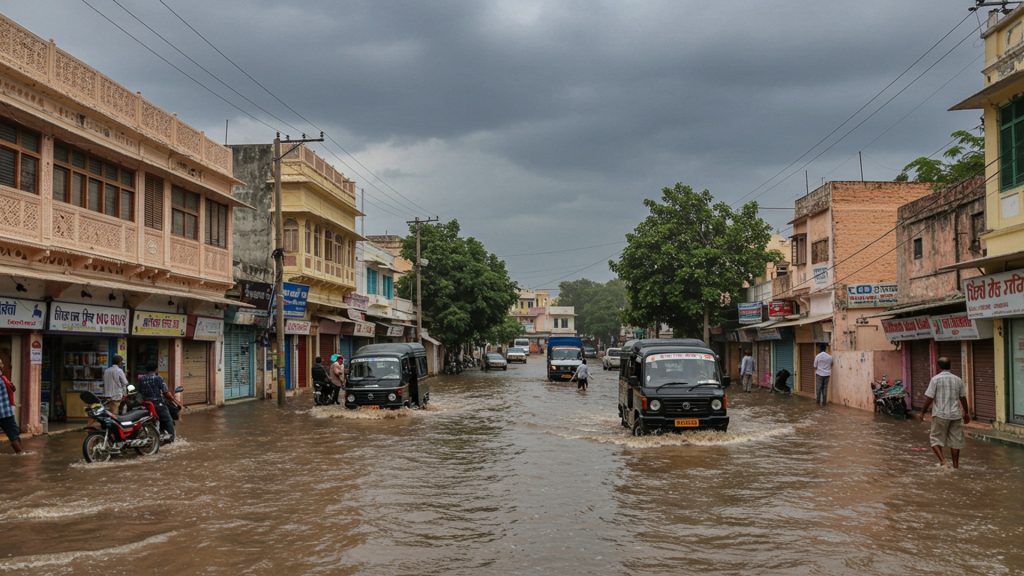Heavy monsoon rains continue to hit Rajasthan with full force, bringing widespread trouble as the state braces for even more downpours today and in the coming days. Rivers are already flowing high. many areas face severe flooding, disrupting daily life for thousands of people. Emergency teams are ready as the weather office warns of very heavy rain, adding to the challenges faced by towns and villages already struggling with waterlogged streets and damaged homes. The ongoing wet spell brings renewed worry about safety and property across the region.
Heavy Rain Continues
Rajasthan is once again facing strong monsoon rains, with the weather department issuing alerts for continued heavy rainfall across various parts of the state. After a brief slowdown in early August, the monsoon has picked up pace again, especially in eastern Rajasthan. The India Meteorological Department (IMD) has forecast that Udaipur and Jodhpur divisions are expected to receive moderate to heavy rain with thunderstorms over the next four to five days, as of August 16, 2025. Parts of Kota, Ajmer, Jaipur, Bharatpur. Bikaner divisions are also likely to experience light to moderate rain along with thunder. Earlier alerts on August 14, 2025, indicated a heavy rain warning for Kota and Udaipur divisions, with an alert also issued for nine districts. The meteorological department noted that eastern winds from the Bay of Bengal have brought new energy to the monsoon in the state.
Widespread Impact Felt
The continued heavy rainfall has led to significant disruptions across many districts in Rajasthan. Severe flooding has been reported in areas such as Nagaur, Kota, Pali, Jalore, Dholpur, Ajmer, Pushkar, Bundi. Sawai Madhopur. Normal life has been severely affected, with many villages becoming cut off as rivers, drains. dams overflow. In Jaisalmer district, villages in Nachna, Chandan, Bhaniyana. Mohangarh are surrounded by water, with the national highway near Chandan blocked and water entering nearby buildings. Even the Indira Gandhi Canal has suffered considerable damage in several sections. In Bhaniyana, agricultural lands are submerged. machines are being used to remove water.
The human cost of these rains has also been tragic. There have been reports of waterlogging, damage to crops. several deaths linked to rain-related incidents. For example, a 24-year-old man drowned in Hathini Ka Kund in Jaipur after going to bathe with friends. In Dholpur district, two children died when a house collapsed due to heavy rain. State Disaster Management and Relief Minister Kirodi Lal Meena has stated that there has been a noticeable increase in rain-related accidents and deaths this year.
Beyond human lives, the agricultural sector has faced heavy losses for Kharif crops in many districts due to too much rainfall. But, there is also a positive side: the heavy rains have helped increase the state’s water levels. According to a Rajasthan Groundwater Department report from 2024, the average water level increased by 5. 82 meters. Experts believe July 2025 rainfall alone will raise water levels by 3 to 4 mm.
Government Response and Support
In response to the severe weather, the state government and disaster relief agencies have been active. The State Disaster Response Force (SDRF) has been carrying out rescue operations and evacuating people to safer places. For instance, on July 19, 2025, the SDRF rescued 176 people from different areas of Ajmer city between the night of July 18 and the evening of July 19. The SDRF teams remain ready to help citizens in various locations.
To help local administrations, advance funds are being given to District Collectors for disaster management efforts. Officials have been told to take steps to prevent loss of public property. Hospitals across Rajasthan have also been instructed to prepare for the monsoon season. This includes cleaning roofs and drains, checking electrical equipment. making sure there are proper arrangements for patients and their families. Plans are being made at the district level to deal with issues like waterlogging and floods. Rapid response teams are also being set up to treat water-borne diseases and provide quick help in emergencies.
In Dholpur district, where the rising Chambal River posed a flood threat, the Indian Army stepped in to help. The army is providing necessary supplies, moving people from unsafe areas. helping with rescue work. They have also sent a special team with high-capacity pumping sets and long pipes to help manage floodwater more effectively in areas like Sri Ganganagar, which faced severe waterlogging.
“Our government is committed to providing maximum relief to those affected. Compensation is also being provided,” said State Disaster Management and Relief Minister Kirodi Lal Meena, emphasizing the government’s efforts to help affected residents.
Staying Safe: Public Advisories
To keep people safe, authorities have been giving vital advice. Residents are strongly urged to stay away from ponds and rivers. to remain indoors during heavy rain. The Minister of Disaster Management and Relief also noted that many people do not follow these warnings, which can lead to bigger accidents. People should also be aware of the risks of water-borne diseases that often spread during the monsoon season. Hospital preparedness for diseases like malaria, dengue. chikungunya is a key focus.
Monsoon’s Strong Trend
This year’s monsoon has shown an unusually strong impact in Rajasthan. Between June 1 and August 14, 2025, the state received 436. 7 mm of rainfall. This amount has already gone past the seasonal average of 435. 6 mm, which is usually expected by September 30. This means Rajasthan has received its full monsoon rain quota more than a month and a half earlier than usual.
The monsoon arrived about a week earlier than expected and brought continuous heavy rain from the start through the first week of August. June and July saw nearly twice the average rainfall for those months. The rainfall in July 2025 was especially high, reaching 285 mm and breaking a 69-year-old record. Overall, the 2025 monsoon season’s rainfall has already broken a 49-year record for the state, with 664 mm of rain recorded so far, which is 61 percent more than normal.
Looking Ahead
The India Meteorological Department expects good rainfall to continue in the last two weeks of August. While the intensity of rainfall might change, the state remains on alert. The unpredictable nature of floods in Rajasthan makes it difficult to plan. the government’s disaster management plans aim to provide guidelines for preparedness, relief. recovery measures. Ongoing monitoring of rainfall and water levels in tanks and dams is an essential task for officials. The focus remains on helping affected areas and making sure people are prepared for more rain.

